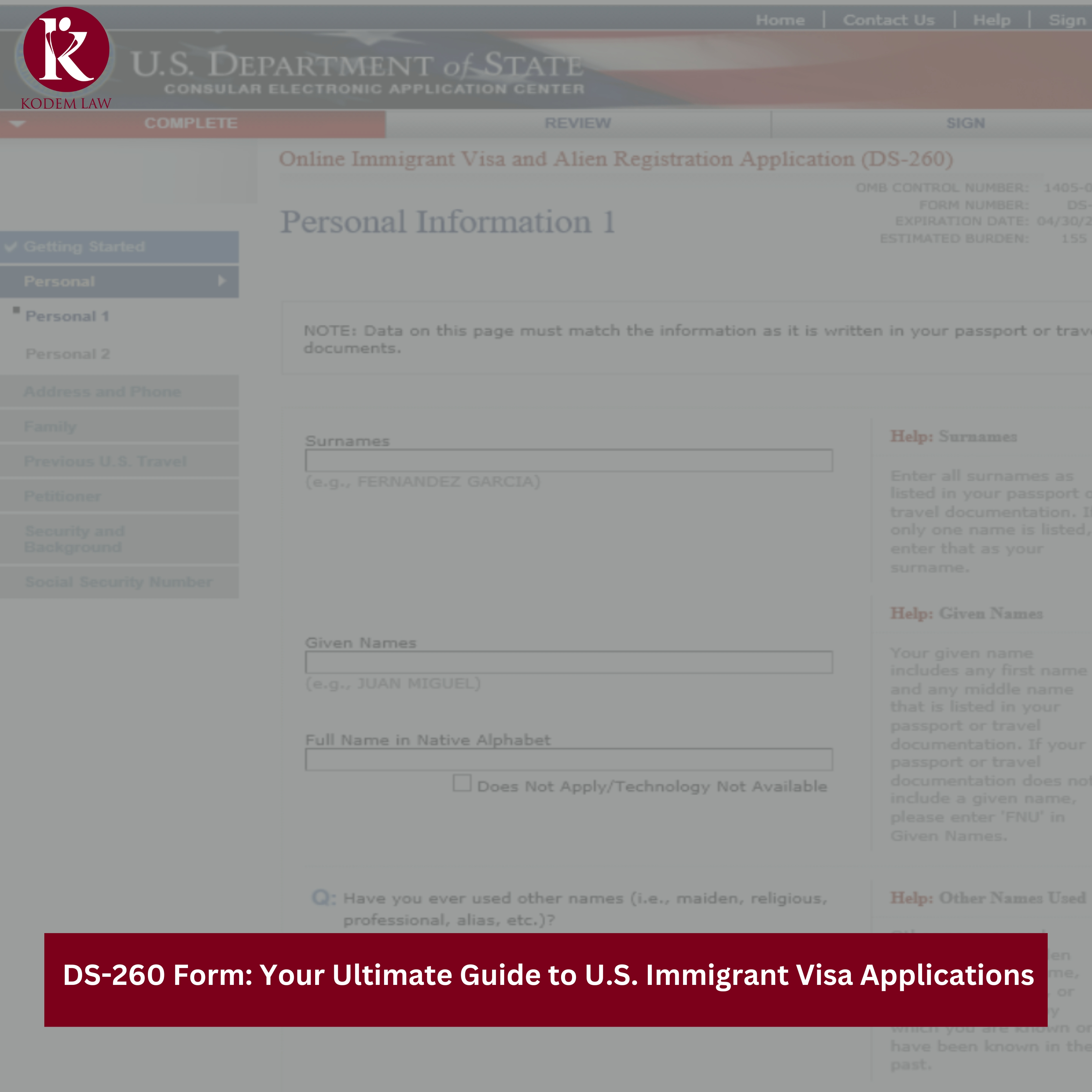
Applying for a U.S. immigrant visa involves several steps, and one crucial part of the process is completing the DS-260 form. The DS-260, also known as the Immigrant Visa Electronic Application, is an essential component for anyone seeking to move to the United States permanently.
This blog will guide you through everything you need to know about the DS-260 form, from understanding its purpose to filing it correctly and tracking its status.
What is the DS-260?
The DS-260, officially known as the Immigrant Visa Electronic Application, is a mandatory online form for individuals applying for a green card from outside the United States. This application is crucial for those seeking to immigrate to the U.S. permanently through various channels, including the Diversity Visa Lottery and marriage-based green card processes, while residing abroad. Handled through the National Visa Center (NVC) and the applicant’s local U.S. Embassy or consulate, the DS-260 collects comprehensive biographical and background information.
This includes details such as the applicant’s residence history since the age of 16, educational background, family members and so on. Once submitted, the DS-260 is reviewed by the NVC to determine the applicant’s eligibility for an immigrant visa. Approval of the DS-260 is a pivotal step in the consular processing application, leading to an interview at the U.S. Embassy or consulate and, upon successful completion, issuance of an immigrant visa for lawful permanent residence in the United States.
What Is the National Visa Center (NVC)?
The National Visa Center plays a key role in the U.S. immigration process. After your immigrant petition is approved by USCIS, the NVC takes over to handle the pre-processing of your visa application. This includes collecting the necessary forms and documents, such as the DS-260. If you are applying for an immigrant visa or a green card from outside the United States through consular processing, you’ll interact with the NVC throughout your application process.

What Is Consular Processing?
Consular processing is the procedure through which immigrants apply for an immigrant visa (green card) from outside the United States. After submitting the DS-260 form, applicants attend an interview at a U.S. consulate or embassy in their home country. If approved, they can enter the U.S. as lawful permanent residents. This method is one of two paths for obtaining an immigrant visa through family-based immigration, the other being adjustment of status for those already in the U.S. Consular processing is the only option for applicants outside the U.S. In this process, the petitioner is a U.S. citizen or lawful permanent resident, and the beneficiary is a foreign national seeking a green card.
What are the Fees for the DS-260?
Filing the DS-260 form incurs certain fees. As of the current guidelines, the processing fee is typically $325 and is required for USCIS to create and send you your physical green card. As soon as you receive your visa stamp, which you will use to enter the United States, it’s important to pay the fee online. USCIS will send the physical green card to the U.S. address you specified three to four weeks later but it’s essential to check the latest fee structure on the U.S. Department of State’s website, as fees can change.
Supporting Documents Required for DS-260
When submitting the DS-260, you’ll need to provide various supporting documents, including:
For the Applicant (Relative)
1. Proof of Nationality:
- Copy of birth certificate
- Copy of passport photo page
2. Proof of Marital Status:
- Marriage certificate (if marriage-based)
- Marriage termination documents such as Divorce certificate, Death certificate
3. Military Records (if applicable):
- Copy of military record
4. Police Certificates:
- From any place in your home country where you lived for at least six months after age 16
- From any place outside of your home country where you lived for at least one year after age 16
- From any jurisdiction where you’ve ever been arrested or charged with a crime, regardless of how long you lived there or what age you were at the time
For the Sponsoring Relative
1. Proof of Financial Support:
- Affidavit of Support (Form I-864)
2. Proof of Marital Status (if applicable):
- Copy of marriage termination documents:
- Divorce certificate
- Death certificate
3. Proof of Domicile:
- Proof of address in the United States (e.g., utility bill, lease agreement)
- State-issued ID or driver’s license
- For those living outside the United States, evidence showing intent to reestablish domicile in the U.S.
Tips for Filing the DS-260 Form
- Review specific requirements: Check the notice from the National Visa Center (NVC) for any special requirements related to your case or the consulate processing your application.
- Follow submission instructions: Adhere to the NVC’s guidelines for submitting documents, which may involve uploading, emailing, or mailing physical copies.
- Submit copies, not originals: Only submit copies of your official documents. Bring original documents to your immigrant visa interview.
- Submit documents together: Ensure that all supporting documents are submitted in one package for efficiency and completeness.
- Double-check all information: Ensure all details are accurate and match your supporting documents.
- Save your work: The DS-260 form can take time to complete. Save your progress regularly to avoid losing information.
- Be honest: Provide truthful answers to all questions to avoid complications later.
- Keep a copy: Print or save a copy of your completed DS-260 form for your records.
Checklist: How to File DS-260?
Filing your DS-260 is just one step in your immigration journey. Before you can file the DS-260, you must first receive approval for your Form I-130. This involves paying all necessary fees and submitting the required supporting documents. Once these steps are completed, you can proceed to file your DS-260.
- Make sure that you have your case number ready, and beneficiary ID number (the person you are sponsoring), and check your NVC welcome notice for the invoice number.
- You must include information about any children you have in your form. This includes all biological, step, or adopted children, regardless of their age or whether they will be accompanying you to the U.S. All children must be mentioned in your application.
- List all the places where you have lived since you turned 16, including both official addresses and any other places where you stayed permanently.
- The green card will be mailed to you, so you must include the most up-to-date physical mailing address on your form. If you provide incorrect information, it will just take longer for you to receive your green card.
- After checking the information submit it and wait for the notification. Once submitted, make sure to print the confirmation page, as it will be required at the interview.
Note: If you made a mistake on your DS-260 form, there is no way to fix it, which means that you cannot amend an already submitted form. However, this doesn’t mean that you have to start from the beginning or that your entire immigration process is ruined. You must simply let the U.S. consulate interviewing officer know about the mistake. It is a common practice for consulate officers to correct some application mistakes.
How Long Does Form DS-260 Take to Process?
Processing times for the DS-260 can vary. Generally, it can take several weeks to a few months from the submission of the form to the scheduling of your visa interview, depending on the caseload at the NVC and the consulate or embassy.
How to Check Form DS-260 Status?
Here is a step-by-step guide to checking your US visa status online for stamping in your passport:
Step 1: Visit the CEAC Website
Go to the Consular Electronic Application Center (CEAC) website, part of the US Department of State, at https://ceac.state.gov/ceac/. This is where you created your DS-160 or DS-260 visa application.
Step 2: Click ‘Check My Visa Application Status’
Depending on whether you applied for a Non-immigrant Visa or an Immigrant Visa, click on the corresponding link to “Check My Visa Application Status” on the CEAC website.
Step 3: Enter Required Information
- Location: Select the location where you attended your US visa interview.
- Application ID: Enter the Application ID from your US Visa Appointment confirmation letter or the DS-160 application.
- Case Number: Enter your case number if provided by the consulate.
Step 4: View Your US Visa Status
After entering all required information correctly and passing the spam bot check, you will see your US visa status displayed. This status can be one of several possibilities, such as Administrative Processing, Issued as the status.
How Can Kodem Law Help You?
The immigration process can be complex and stressful. At Kodem Law, our experienced attorneys specialize in immigration law and can guide you through each step to ensure your DS-260 form is filed correctly and promptly. We provide personalized assistance tailored to your individual needs, helping expedite the process and address any issues that may arise. By following this guide and with our expert guidance, you can better understand the DS-260 form and streamline your path to becoming a lawful permanent resident of the United States.
Contact Kodem Law today for a consultation on your visa application status or any immigration matter.


i want to know when will i get my visa
Hello! For more information, you can contact us at:
(888)-955-6634
info@kodemlaw.com
i want to know when will i get my Dc 260 visa
Hello! For more information, you can contact us at:
(888)-955-6634
info@kodemlaw.com